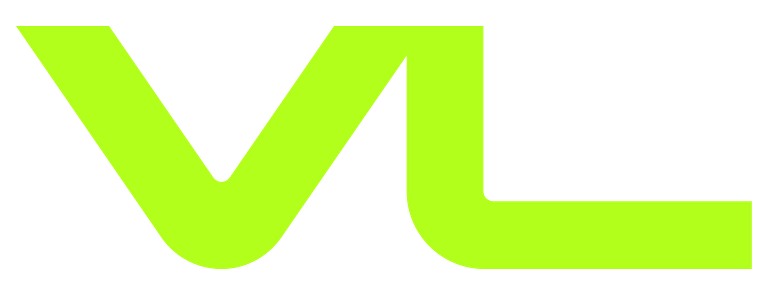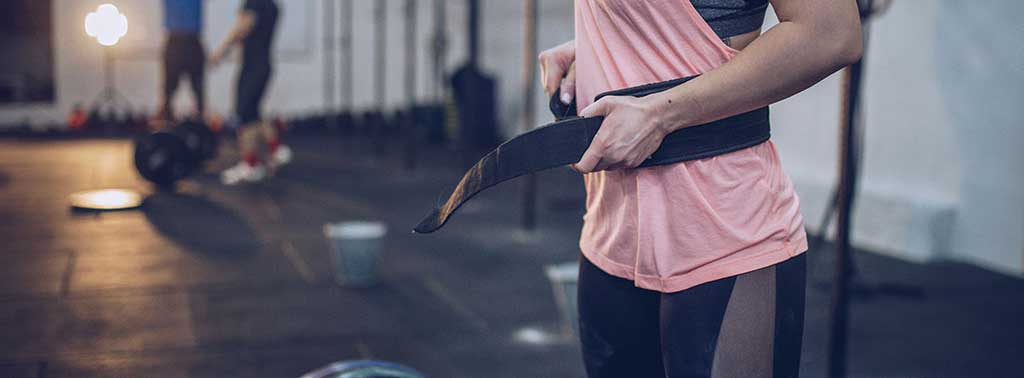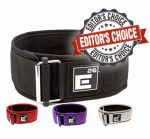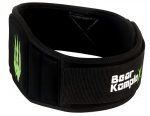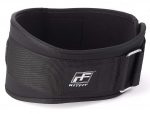If you want to boost your squats and deadlifts, then a vegan lifting belt might do the trick.
If you use a vegan lifting belt properly, you can take advantage of heavier lifts while keeping your form safer and more efficient.
A lifting belt is as important as a good pair of gym shoes and a bodybuilding program if you’re really in it for optimum gains.
Sadly, if you’re looking for a well-known high-quality lifting belt, it’s often made out of leather. It’s a bit like looking for a sofa.
Nevertheless, we’re undeterred by this challenge, and we went on a quest to find the best vegan lifting belt! In today’s post, I will share my discoveries with you so you can lift heavier weights in a cruelty-free manner.
I don’t make a dime from these recommendations. It’s just that these vegan powerlifting (see also ‘The Best Powerlifting Exercises and Workout Gear‘) belts I have found are extraordinary and great for a vegan powerlifters.
Let’s take a look at what makes them so awesome.
Our Best Vegan Lifting Belts ([year] Updated)
|
PRODUCT |
PRODUCT DETAILS |
|---|---|
|
OUR #1 RATED
Element 26 |
|
|
OUR #2 RATED
Fire Team Fit |
|
|
OUR #3 RATED
Harbinger |
|
|
OUR #4 RATED
Bear KompleX |
|
|
OUR #5 RATED
RitFit |
|
1. Element 26 Self-Locking Weightlifting Belt (Editor’s Choice)
If you’re looking for a vegan powerlifter belt (see also ‘How To Add Powerlifting to Your Workout Routine‘) which is secure around your body, then Element 26’s belt with self-locking technology is what you might need.
The self-locking technology allows for injury-free use as it will not loosen during your lifts.
This belt is made from 100% premium nylon and is designed with for a wide range of athletes: Powerlifters, Olympic lifters, and CrossFit athletes.
Personally, I love that this belt is competition approved – which means I can use it in future competitions if I ever do decide to join one; I just need to get stronger first.

PROS
- Made from 100% premium nylon
- Has a quick release buckle for faster movements
- Adjustable to get the perfect fit
CONS
- Lack of lower back support in some users
It’s approved for use in USAW and CrossFit Competitions so you can rest assured that you’re getting a functional and practical weightlifting belt.
With a lifetime warranty, why wouldn’t you get it?
2. Fire Team Fit Weightlifting Belt
Fire Team Fit offers tough, durable and heavy-duty belts made out 100% vegan materials that provide good support for heavy squats and deadlifts (see also ‘Everything You Need To Know To Accomplish Proper Deadlifts‘).
They can be used by either casual lifters or for competitive powerlifting, strongman lifting, Olympic lifting, or other types of strength sports.
Unlike traditional leather belts with a set of holes, the hook support strap enables you to adjust this belt’s tightness for the desired comfort and stability specifically needed for your leg and core body movements.

PROS
- Made from vegan-friendly materials
- Promotes good form while weightlifting
- Provides abdominal and lower back support
CONS
- Doesn’t give you a leather feel since it is made from nylon
What’s making it more highly recommendable is that its made from softer, lightweight, and flexible vegan materials (see also ‘Organic Clothing: Is It Sustainable?‘) that will make your weightlifting sessions more comfortable.
All in all, these belts are high-quality and have a reliable track record as they’ve been used during 800+ pound deadlifts (see also ‘The Benefits Of Adding A Deadlift To Your Leg Workout Routine‘) and squats. It also says a lot that Fire Team Fit offers a lifetime performance warranty for them too – they obviously trust their product!
3. Harbinger Weightlifting Belt
For a lifter that doesn’t have plans of squatting or deadlifting more than 400-500 pounds, a belt such as the Harbinger Lifting Belt still manages to impress.
This belt is made out of thick and flexible cell foam, surrounded by abrasion-resistant nylon that provides both support and comfort.
It comes with a heavy gauge steel roller buckle, along with a velcro system which makes tensioning secure and simple.
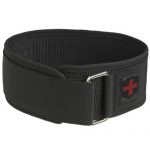
PROS
- Made from abrasion-resistant fabric
- Gives maximum lower back and abdominal support
- Provides comfort during weightlifting belts
CONS
- Not suited to more serious powerlifting activities
- Velcro tensioning system is not nearly as reliable or secure as a single prong, double prong, or lever belt
The flexibility and less-stiff material make this belt suitable for CrossFit, or some other functional fitness type training routine where you want to transition between heavy lifting and doing box jumps and burpees in the same workout.
4. Bear KompleX
Despite its unusual name, this Bear KompleX belt is ideal for deadlifts, snatches, squats, and much more, allowing you to get the support you need for various bodybuilding exercises (see also ‘Neck Mobility: Exercising Your Sternocleidomastoid‘).
4 inches of strong Velcro make for easy and stable fastening, helping you to maintain your balance and keep your core strong when doing demanding exercises (see also ‘Exercising After A Hip Replacement‘).
Whether you’re pumping bars/dumbbells or doing squats, this is a great weightlifting belt to use and it’s comfortable too. Owing to the support provided a good belt will always be snug and you’ll know it’s there, but you want that to feel more like a bear hug than a pinch and the Bear Komplex has that comforting grip.

PROS
- For extreme stability and support during crosstraining and other workouts
- Improves balance during weightlifting
- Made from vegan-friendly materials
CONS
- Velcro can become weak after a while – single prong and double prong may be better
The only real drawback is that it looks a little tacky, when compared to other entries on the list it is really lacking in the sleek and stylish department, but when it performs that well who cares if it looks a little grizzly?
5. RitFit
Ideal if you’re doing a lot of strength training, (see calisthenics) the RitFit weightlifting belt is ergonomically designed in order to provide lumbar support and keep your back in good condition throughout your gym session.
It comes with a 6-inch wide foam core which is waterproof (i.e. sweatproof) and has a hook and loop closure for secure fastening. This belt is designed to be supportive of your back and abdomen, which is great if you have problems with these areas.
This belt has been specifically designed with smaller frames in mind meaning it’s a fantastic choice for the shorter lifter as well as those of the fairer sex.

PROS
- Made from waterproof foam core
- Supports back and abdomen while powerlifting
- Good for deadlifts and squats
CONS
- Can be hard to find in larger sizes
This does mean however that they don’t provide as much allowance for larger builds and if you’re of an Atlantian or Amazonian build this might not be the best belt for you.
The RitFit isn’t going to win any style awards but it is straight, sleek, and to the point. It has been designed to help you achieve peak performance and it’s a great choice for smaller athletes that won’t break the bank.
Other Resource You May Like:
- Best Vegan Motorcycle Gears
- Best Vegan Hiking Boots
- Best Vegan Clothing Brand
- Best Vegan Weightlifting Shoes
- Best Vegan UGGs
What do lifting belts do?

When you lift or push something heavy, your body instinctively wants you to hold your breath – this is referred to as the Valsalva maneuver. The pressure you feel building up is called intra-abdominal pressure.
Alas, this pressure is the foundation of every properly-done heavy squat, deadlift or compound movement. A good weightlifting belt allows you to augment this pressure even more, acting almost like a second set of abdominals, meaning you can lift heavier weights.
Some people claim that powerlifting belts are “unnatural”, but last time I checked, protein shakes, treadmills, and yoga (baby Yoga) pants don’t occur naturally in the wild either. If you’re safe and use proper technique, you’ll see the weight lifting belt benefits which are possible.
In combination with equipment such as proper gym shoes, supplements, and a muscle-building program, a lifting belt can help you up your game in the gym.
For advice on vegan weightlifting shoes, check out The Best Vegan Weightlifting Shoes.
You might consider wearing a weightlifting belt if you’re doing powerlifting or dead lifts. A weightlifting belt can be a reminder to keep your spine (see also ‘Spinal Decompression Exercises For Your Neck, Back, And Spine‘) in the correct position and can help maintain abdominal pressure to stabilize the spine during heavy lifting.
Edward R. Laskowski
Doctor of Medicine
Who Should Use a Lifting Belt?
Any complete beginner in the gym should probably not be using a lifting belt.
The first objective of any new lifter (see also ‘Eccentric Leg Exercise Workouts For Advanced Lifters‘) should first be to correctly perform the lifts and brace using the core musculature. After first establishing a solid lifting and breathing technique, you can go ahead and put on a belt – don’t rush to it.
At the point where you’re pulling and squatting some decent weights, there’s really nothing stopping you from benefiting from a lifting belt, especially if you have a history of back injuries and you want to stave off any future similar accidents.
When Should You Use Your Belt?

Essentially, you should put on your lifting belt whenever a big, strong-braced core comes in handy. This could be in exercises (see also ‘Wheelchair And Upper Body Exercises For Paralyzed Lifters‘) and movements such as:
- Squat variations: High-bar squats, low-bar squats, front squats etc.
- Deadlift variations: Sumos, deficit pulls, rack pulls etc
- Overhead press (see also our guide to press techniques).
- Bench press (it involves the entire body when you use a technique that allows for the most weight to be lifted)
- Clean and jerks
What to Look For in a Vegan Lifting Belt
So first and foremost let’s ensure that no animals were harmed in the making of the lifting belt:
- It should not be made out of leather or in any way use any animal products.
- It should be made out of durable and heavy-duty synthetic materials that will provide excellent stability and that you can brace against during heavy lifts
- It should feature a high-quality tensioning system so that you can place a good amount of tightness around your core. Single prong and double prong systems are common, for example.
FAQ
Where should your weight lifting belt sit?
Your weight lifting belt should sit so that it covers your erectors and abdominal muscles (see also ‘ Strengthening Your Rhomboid And Surrounding Neck Muscles ‘). This is usually 1-2 inches above your pelvis, although this can vary depending on your body shape and glute development. You want to ensure that the belt is providing lots of intra-abdominal pressure.
Should I wear a belt when Deadlifting?
You should usually wear a belt when deadlifting (see also ‘Deadlift Straps: Our Honest Review‘), as you’re using your core muscles to lift a weight. More experienced deadlifters may not require a belt anymore, but people perfecting their technique should seek the assistance of a belt and reap the weight lifting belt benefits.
What size lifting belt do I need?
When it comes to the size of your lifting belt, you need to measure around your waist in a relaxed state without sucking your stomach in. This is usually around 4 inches above where your pants (see also ‘The Best Leggings For Runners’) naturally sit. Choose a belt with the waist size that you measured for the best fit.
How tight should my lifting belt be?
Your lifting belt should be tight enough to give you something to push against, but not so tight that your abdominals cannot contract properly. When putting your belt on, hold your breath and contract your core as you would when lifting. Tighten your belt until it finds this spot, and then tighten it a little more.
Do lifting belts help with lower back pain?
Many lifting belts can help with lower back pain (see also ‘Exercises To Relieve Nerve Pain‘) and provide you with lumbar support. However, these weight lifting belts are primarily designed for core abdominal support, so they may not support everyone’s backs (see also ‘The Benefits Of Lat Pull Downs: Back Exercises To Reduce Lumbar Stress‘) as much as they would like them to.
Do lifting belts prevent injury?
Lifting belts do not prevent injuries (see also ‘10 Best Ways To Exercise With A Bad Knee‘), so you should always use safe techniques and spotters when performing heavy lifts. Lifting belts are primarily designed to give your core muscles something to brace against, helping you to lift heavier weights than normal. The best way to prevent injury is through proper training and technique.
Our Favorite Vegan Lifting Belt
All is said and done, and we have to recommend the Element 26 Self-Locking Weightlifting Belt as our favorite vegan powerlifting belt! Not only is it animal-free, but it’s also very versatile – you can use it for powerlifting competitions, bodybuilding, squatting, and more!
Instead of using a single prong or double prong fastening system, it uses a unique hook support strap which makes it easy to adjust the belt to the perfect size for you and your needs.
These belts have been used on heavy lifts such as 505 pound squats (by @sodiff) and 495 pound deadlifts (by @chocolateviking), so we’re pretty sure that their proof is in the (heavy) pudding!

Element 26 Self-Locking Belt
Our #1 Vegan Weightlifting Belt
- Very durable (100% premium nylon)
- Has a quick release buckle for faster movements
- Adjustable to get the perfect fit
- Lifetime warranty
- Comfortable when compared to other belts
[tcb-script type=”application/ld+json”]{“@context”: “http://schema.org/”,”mainEntityOfPage”: “https://veganliftz.com/best-vegan-lifting-belts/”,”@type”: “Article”,”headline”: “What’s the Best Vegan Weightlifting Belt? Reviews & Buyer’s Guide”,”datePublished”: “2019-09-30″,”dateModified”: “2019-11-05″,”description”: “We will help you find the best, heavy-duty VEGAN LIFTING BELTS so you can squat and deadlift hundreds of pounds in a cruelty-free fashion (see also ‘The Top Hemp Clothing Companies‘). Our #1 recommended belt is…”,”keywords”: [“vegan powerlifting belt”, “vegan weight lifting belt”, “vegan lifting belt”],”image”: {“@type”: “ImageObject”,”height”: “628”,”width”: “1200”,”url”: “https://mlbmbvodvbvn.i.optimole.com/w:auto/h:auto/q:100/f:best/https://veganliftz.com/wp-content/uploads/2017/10/BEST-VEGAN-LIFTING-BELTS.jpg”},”author”: “Jason Hughes”,”publisher”: {“@type”: “Organization”,”name”: “Vegan Liftz”,”sameAs”:[“https://www.facebook.com/veganliftz/”,”https://twitter.com/veganliftz”,”https://www.pinterest.com/veganliftzofficial/”,”https://www.instagram.com/veganliftz/”,”https://www.youtube.com/channel/UCVilJCjZsaI1Q50fbM_IsnQ”,”https://goo.gl/maps/sC3u4cuyWLqYwhBY7″],”logo”: {“@type”: “ImageObject”,”url”: “https://mlbmbvodvbvn.i.optimole.com/w:auto/h:auto/q:100/f:best/https://veganliftz.com/wp-content/uploads/2019/04/Veganliftz_White_Small.png”}}}[/tcb-script]
- Why is My Poop Black: Uncovering the Causes and Solutions - December 21, 2023
- Clear Protein Drinks: Optimal Hydration and Muscle Support for Athletes and Fitness Enthusiasts - December 21, 2023
- Does Apple Juice Make You Poop: Uncovering the Digestive Effects - November 29, 2023
